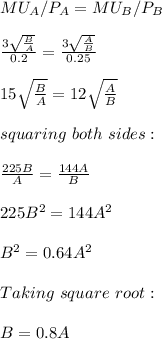Answer:
Therefore, Olivia should buy 10 apples and 8 bananas to maximize her utility.
Step-by-step explanation:
Let A represent the number of apples bought and B represent the number of bananas bought. Therefore since Olivia has $4 to spend:
0.2A + 0.25B = 4 (1)
Also, the tangency condition can be used to find the optimal amount of A to relative to B. It is give as:

Put B = 0.8A in equation 1:
0.2A + 0.25(0.8A) = 4
0.2A + 0.2A = 4
0.4A = 4
A = 10
B = 0.8(A) = 0.8(10) = 8
Therefore, Olivia should buy 10 apples and 8 bananas to maximize her utility.